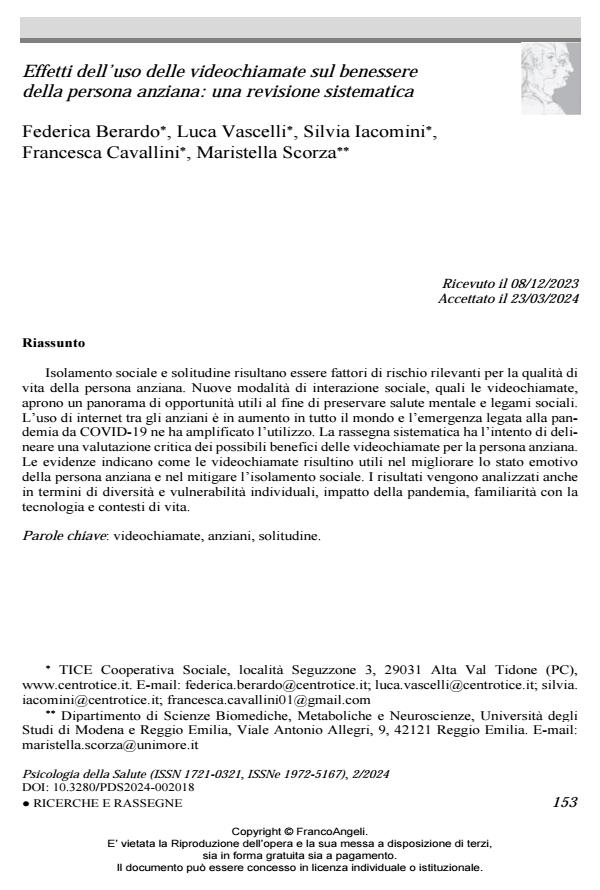Effetti dell’uso delle videochiamate sul benessere della persona anziana: una revisione sistematica
Titolo Rivista PSICOLOGIA DELLA SALUTE
Autori/Curatori Federica Berardo, Luca Vascelli, Silvia Iacomini, Francesca Cavallini, Maristella Scorza
Anno di pubblicazione 2024 Fascicolo 2024/2
Lingua Italiano Numero pagine 23 P. 153-75 Dimensione file 404 KB
DOI 10.3280/PDS2024-002018
Il DOI è il codice a barre della proprietà intellettuale: per saperne di più
clicca qui
Qui sotto puoi vedere in anteprima la prima pagina di questo articolo.
Se questo articolo ti interessa, lo puoi acquistare (e scaricare in formato pdf) seguendo le facili indicazioni per acquistare il download credit. Acquista Download Credits per scaricare questo Articolo in formato PDF

FrancoAngeli è membro della Publishers International Linking Association, Inc (PILA)associazione indipendente e non profit per facilitare (attraverso i servizi tecnologici implementati da CrossRef.org) l’accesso degli studiosi ai contenuti digitali nelle pubblicazioni professionali e scientifiche
Isolamento sociale e solitudine risultano essere fattori di rischio rilevanti per la qualità di vita della persona anziana. Nuove modalità di interazione sociale, quali le videochiamate, apro-no un panorama di opportunità utili al fine di preservare salute mentale e legami sociali. L’uso di internet tra gli anziani è in aumento in tutto il mondo e l’emergenza legata alla pandemia da COVID-19 ne ha amplificato l’utilizzo. La rassegna sistematica ha l’intento di delineare una valutazione critica dei possibili benefici delle videochiamate per la persona anziana. Le eviden-ze indicano come le videochiamate risultino utili nel migliorare lo stato emotivo della persona anziana e nel mitigare l’isolamento sociale. I risultati vengono analizzati anche in termini di diversità e vulnerabilità individuali, impatto della pandemia, familiarità con la tecnologia e con-testi di vita.
Parole chiave:videochiamate, anziani, solitudine.
- Autodétermination et pouvoir d’agir dans le monde du handicap Silvia Iacomini, Matilde Fabiani, Luca Vascelli, Federica Berardo, Francesca Cavallini, pp.133 (ISBN:9782810912049)
Federica Berardo, Luca Vascelli, Silvia Iacomini, Francesca Cavallini, Maristella Scorza, Effetti dell’uso delle videochiamate sul benessere della persona anziana: una revisione sistematica in "PSICOLOGIA DELLA SALUTE" 2/2024, pp 153-75, DOI: 10.3280/PDS2024-002018